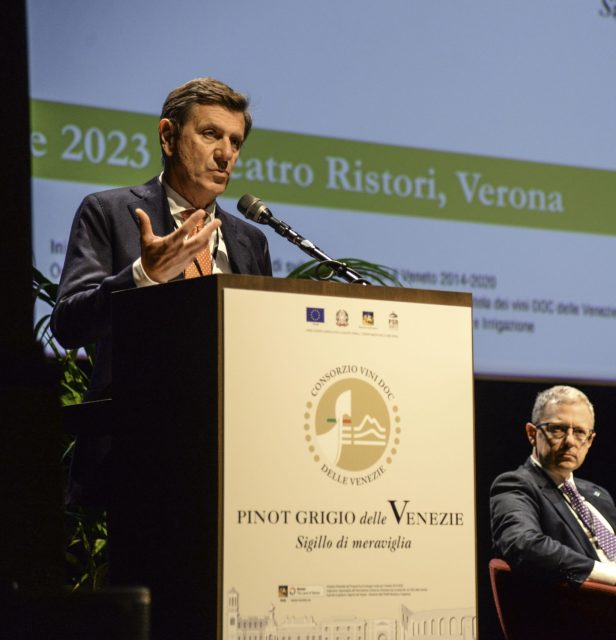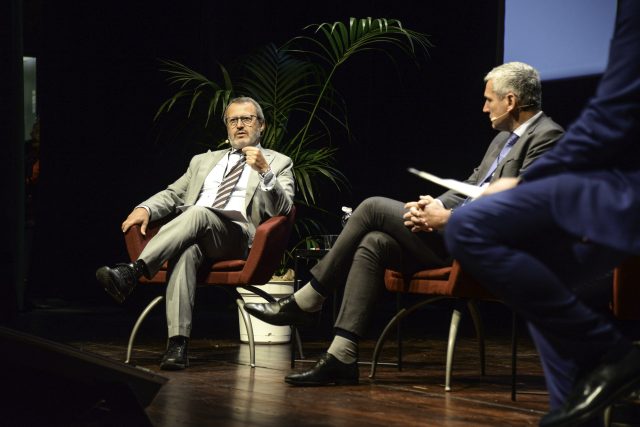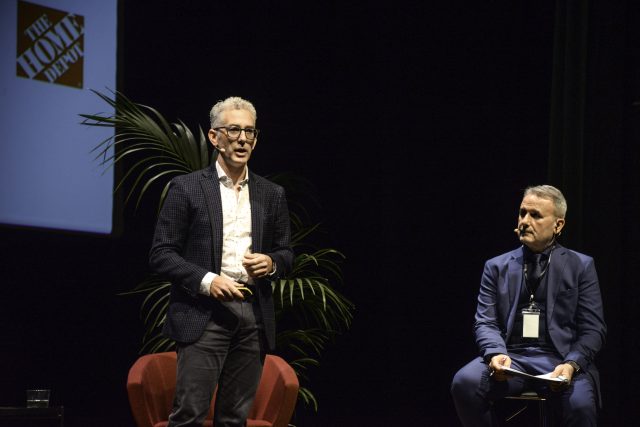This website uses cookies so that we can provide you with the best user experience possible. Cookie information is stored in your browser and performs functions such as recognising you when you return to our website and helping our team to understand which sections of the website you find most interesting and useful.
What does the future hold for Pinot Grigio?
From premiumisation to growing interest in dealcoholised wines, last weekend’s Delle Venezie DOC International Forum gave some insight into the commercial challenges and opportunities that lie ahead for north-eastern Italian Pinot Grigio.

Constituting 85% of Italy’s Pinot Grigio production and 43% of the world’s, Delle Venezie DOC covers some 27,000 hectares across the regions of Veneto, Trento and Friuli Venezia Giulia. At present, the area producers some 250 million bottles of Pinot Grigio per annum, wine production figures second only to those of Prosecco DOC in Italy.
The conference, held in Verona over two days, saw figures ranging from politicians to wine tech gurus offer their insight on several of the hot, and highly controversial, topics in the industry. Pinot Grigio delle Venezie, due to its sheer popularity, is very much the canary in the coal mine.
Healthy debate
One issue consistently mentioned was the incoming changes in Ireland that will see alcoholic products labelled with health warnings, a move that has particularly infuriated those in the Italian wine industry.
Roberto Pachher, vice president of the regional council of Trentino-Alto Adige, exclaimed: “We have to reject initiatives like that in Ireland – this is not acceptable…Anything can cause harm to health, wine is not a danger, it is an excellence we will defend at all costs.”
Luca Rigotti, who has many feathers to his cap including Mezzacorono Group president and Consorzio delle Venezie board member, pulled no punches when he suggested that the policy has come about due to differences in drinking cultures: “In many countries there is an alcoholism problem – this is not the case in wine producing countries. We don’t see wine as a beverage, but as a sort of food. We have to develop a culture of moderate drinking among the new generation.”
Trentino-Alto Adige resident Herbert Dorfmann MEP, a member of the European Parliament’s Committee on Agriculture and Rural Development, added: “Writing on the label that wine harms health goes against the single market model…if one state does it, it’s going to be a mess.”
However, despite these expressions of disapproval towards the view of alcoholic drinks as something dangerous, the growth of the no- and low-alcohol trend could present a significant opportunity for Pinot Grigio delle Venezie.
The “new generation”, as Rigotti called them, does seem to be drinking an awful lot less than their parents and grandparents. Wine Intelligence founder and IWSR non-executive director Lulie Halstead presented data that might make grim reading for many in the drinks industry: in the US, 54% of drinking age (21 and above in the US) Generation Z members abstain from alcohol. For the overall adult population, that proportion is 37%.
Sandro Sartor, Consorzio delle Venezie board member and president of Wine in Moderation, spoke of changing consuming behaviour between age groups: “If you listen to the news, all kids are binge drinking, but the statistics prove the contrary…There is greater attention paid to ‘betterment’: people want to feel better, whether it’s drinking sustainable, organic or natural wines, or thinking about calories. Low-alcohol wines can meet these requirements.”

Sartor argued that if the Italian wine industry did not embrace the chance to loosen restrictions on alcohol levels in wines it would be “shooting itself in the foot”: “We need to become more approachable for young people.”
Perhaps, given alcohol is a major contributor to the body/texture of a wine, Pinot Grigio’s already light style lends itself to a low-/no-alcohol product. At present, the consorzio dictates that for a wine to be labelled as Delle Venezie DOC, it must have a minimum alcohol level of 11%.
Consorzio president Albino Armani noted that Delle Venezie DOC has held strong in the face of changing consumer habits, and he expressed optimism that this will continue: “Despite the general trend in wine consumption decreasing, our denomination is showing quantitative growth while maintaining price stability. We are in a revolutionary phase in which new trends are underway: the strength of Pinot Grigio is to remain steadfast in consumption through the succession of fashions, and this is made possible thanks to an extremely cohesive production chain.”
Know your audience
Another issue raised by Halstead was competition from other categories, as those US consumers who do drink are, generally speaking, veering towards spirits and ready-to-drink cocktails (RTDs), at the expense of wine. While the value of the wine category took a 0.5% dip between 2021 and 2022, spirits went up by 4.2% and RTDs by 6%.
But rumours of the death of wine, alcohol and all, have been greatly exaggerated.
Halstead said that it was “kind of true but also not true” that young Americans aren’t ‘participating’ in wine. Compared to a 2010 baseline, every age group from 25-34 up to 65+ has increased its ‘participation’ in wine this year (though, worryingly, the only group where it is gone down is for 24s and under). What this proves is that more people are drinking wine, they’re just not drinking more wine.
Indeed, Pinot Grigio/Gris is still the second most consumed white wine in the US, after Chardonnay, according to IWSR data, with 42% of wine drinkers surveyed in 2022 claiming to have drunk it in the last month (for Chardonnay that figure was 47%, and 36% for Sauvignon Blanc).
Halstead also shared that the trend points to consumers wanting to buy wine less frequently, but spending more per bottle when they do. According to an IWSR study examining the US wine market as a whole, the Compound Annual Growth Rate (CAGR) for any wine under US$9.99 will have dropped significantly by 2026, whereas the CAGR for higher price brackets will grow. The most notable boost will be seen in the ‘ultra-premium’ US$30 to US$49.99 category, which, from a 2021 baseline, will go up by 8.3% each year in the next three years. Wine drinkers, by and large, are trading up, but are they prepared to spend that extra money on Pinot Grigio?
The fundamental tension that seems to exist within the Pinot Grigio delle Venezie category is the seeming contradiction between the complex, aromatic wines that Pinot Grigio can produce, and the relatively simple, fresh wines that most consumers around the world expect from it. Ray O’Connor MW elaborated during a blind tasting of different styles produced from this grape: “For a grape that is incredibly widely recognised, there is a lack of understanding of its potential.”
Noting the “reliability and consistency” that consumers have come to expect from Pinot Grigio delle Venezie DOC, O’Connor suggested that there is wiggle room for these wines: “It [Pinot Grigio] can capture and retain the market with its freshness and softness…It’s a simple step from one category to the other, and in retail that’s all you want.”
These more ‘premium’ styles tend to be harvested later, often with greater phenolic extraction in the cellar, they are also more terroir-driven, with the winemakers keen to emphasise how soil composition has influenced what’s in the bottle.
Wine education specialist Frank Smulders MW, who teaches WSET across Europe, noted that inexpensive and simple north-eastern Italian Pinot Grigio is still contrasted with more complex Pinot Gris from Alsace as a teaching tool. He also warned that consumers want to know what they’re buying when they pick up a bottle: “As wine lovers, we always think creating more diversity is very helpful, but that’s only the case for 0.5% of the market…The reality of the wine business is that most wine is consumed by non-educated wine drinkers.”
It might be suggested that inexpensive, simple wine can act as a gateway for consumers to buy a more expensive, more complex product made from the same grape variety.
Whether customers really are prepared to spend more on Pinot Grigio remains to be seen. However, with competing, cheaper Pinot Grigio products from countries such as Romania and Moldova, perhaps these more premium, complex expressions might present a future route for Delle Venezie DOC. O’Connor noted: “Imitation is the greatest form of flattery, but that doesn’t help keep the market share.”
We open in Venice
It is understandable why international competitors are emerging – Pinot Grigio from this corner of Italy has been a truly global success story. Data from wine rating/recommending app Vivino, presented by head of global partnerships Kristi Paris, showed that the countries which have seen the sharpest year-on-year increase in the share of scans of Pinot Grigio bottles are Sweden (12.9%), the Netherlands (8.3%) and Australia (5.1%). The country to have seen the biggest increase in the number of Vivino users viewing pages of Pinot Grigio wines is Japan (14.6% increase year-on-year).
Smulders noted that with one Russian supermarket he works with, Italian Pinot Grigio takes first, second and third spot when it comes to the bestselling wines: “Russian consumers have a very strong preference for Italy.”
However, it might be suggested that in spite of these phenomenal numbers, many consumers are detached from where these products actually come from – a perennial problem with wine.

David Gluzman, CEO of Wine Folly, revealed that Pinot Grigio/Gris is the 15th most searched for grape variety on the wine education platform (Cabernet Sauvignon is first, Chardonnay second, Pinot Noir third), and Italy is the second most searched for wine nation after France (with an 18.4% share, compared to France’s 35.2%). There is certainly room for improvement when it comes to generating interest in the grape and the region.
“Focusing on the region that Pinot Grigio is from is the winning strategy from here,” Gluzman suggested.
Citing the growing importance of social media to communicating to millennial and Gen Z consumers, Gluzman said: “Young people do not care about wine scores, they care about being cool or looking cool.”
Daniele Cernilli, the man behind the Doctor Wine website, expressed agreement with the former point: “Pinot Grigio in the north-east of Italy is like Pinot Noir in Burgundy, it must be reconciled with its production area.”
“Americans might not know where Veneto is,” Cernilli opined, “but they known Venice.”
While the Covid-19 pandemic notably dented the number of visitors to the city, with Satista reporting that 4.6 million tourists, both international and domestic, visited Venice last year. Of course, when one looks at Delle Venezie DOC, with its logo complete with gondola motif, it is obvious that the consorzio, which was founded in 2017, is playing on the wine’s association with La Serenissima with its branding.
“The beauty of our places must be a value to bring to the world,” Cernilli concluded. A romantic sentiment, though don’t be surprised if what this translates to is seeing more and more lifestyle ‘influencers’ posting photos of themselves roaming the canals, glasses of wine in tow. Then again, while there is a tendency to be sniffy about social media in some parts of the trade, it’s clearly going to become an even bigger part of wine marketing strategies in years to come, especially for promoting styles aimed at the general consumer, rather than the wine connoisseur. Venice certainly doesn’t need any more visitors, but if more of those who do go were to do so for the wine, and share photos of it, that could be good news for Delle Venezie DOC.
Final thoughts
The expression that consistently came to mind throughout the forum was: “You either move with the times, or the times move you”.
This summit, the first since 2019, offers a strong indication that the consorzio is very much keeping one eye on the decades ahead, and that it may be prepared to innovate in order to maintain its success. It is a testament to the worldwide popularity of Pinot Grigio delle Venezie DOC that it is a crucial barometer that will determine how the wine industry as a whole should, and should not, react to changes among consumers.
Trends, by their very nature, come and go. Today’s Gen Z teetotallers could well be tomorrow’s weekly wine drinkers, for example. But, it could be a very costly gamble to ignore the patterns that the current data indicate. To quote American cartoonist Bill Watterson: “The problem with the future is that it keeps turning into the present.”
Related reading:
Alto Adige: six wine trends to watch out for

